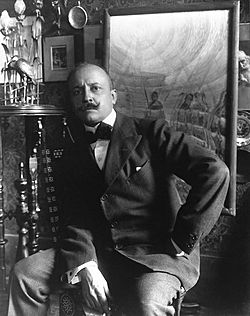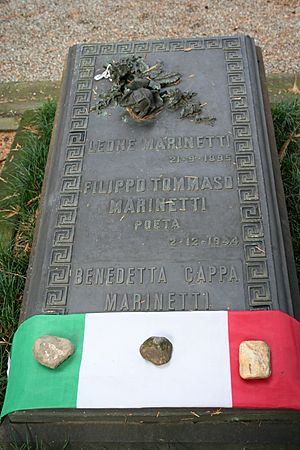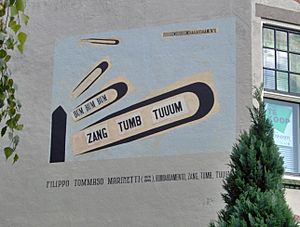Filippo Tommaso Marinetti facts for kids
Quick facts for kids
Filippo Tommaso Marinetti
|
|
|---|---|
 |
|
| Born | 22 December 1876 Alexandria, Egypt |
| Died | 2 December 1944 (aged 67) Bellagio, Italy |
| Occupation | Poet |
| Literary movement | Futurism |
| Spouse | Benedetta Cappa |
Filippo Tommaso Emilio Marinetti (born December 22, 1876 – died December 2, 1944) was an Italian poet, writer, and art thinker. He is famous for starting the Futurist movement. This movement was all about new ideas, speed, and technology. Marinetti also wrote the first Futurist Manifesto in 1909. He was also involved in writing the Fascist Manifesto in 1919.
| Top - 0-9 A B C D E F G H I J K L M N O P Q R S T U V W X Y Z |
Early Life and Education
Filippo Marinetti spent his first years in Alexandria, Egypt. His father, Enrico Marinetti, was a lawyer from Italy. His mother, Amalia Grolli, loved to read poetry. She introduced young Filippo to many classic Italian and European books.
Marinetti's love for writing grew during his school days. When he was seventeen, he started his first school magazine called Papyrus. He even got into trouble with his teachers for sharing exciting novels in the school.
He studied in Egypt and then in Paris, France. He earned a degree in 1894. Later, he studied law in Italy and graduated in 1899. However, he decided not to become a lawyer. Instead, he wanted to be a writer. He tried many types of writing, always signing his work as "Filippo Tommaso Marinetti."
Starting Futurism
Marinetti is best known for creating the Futurist Manifesto. He wrote it in 1909, and it was printed on the front page of a famous French newspaper, Le Figaro. In this manifesto, Marinetti said that art should be bold and strong. He believed in new ideas and wanted to break away from old traditions.
Marinetti loved speed. He had a small car accident in 1908. He said that after this accident, he felt like a new person. He decided to end old ways of thinking in art. He wanted to "destroy the museums, the libraries, every type of academy." He also wrote that they would celebrate war and new ideas worth fighting for. These ideas challenged traditional views and sometimes caused controversy.
The Futurist Manifesto was discussed all over Europe. However, Marinetti's first plays were not always popular. When his play Le Roi bombance (The Feasting King) opened, the audience booed loudly. Marinetti himself even joined in the booing! He liked the idea of being heckled.
Futurist Evenings and New Ideas
In 1910, Marinetti found friends in three young painters: Umberto Boccioni, Carlo Carrà, and Luigi Russolo. They all believed in the Futurist way of thinking. Together, they started "Futurist Evenings." These were like theatrical shows where the Futurists would read their manifestos. Sometimes, the audience would throw vegetables at them!
One famous event was when they shared the "Manifesto Against Past-Loving Venice" in Venice. In this paper, Marinetti wanted to change Venice. He suggested filling the old canals to make way for a new, industrial Venice.
In 1911, Marinetti became a war reporter during the Italo-Turkish War. He wrote articles that were later published in a book. He also visited London, which he called "the Futurist city." He believed London was modern and fast-paced.
Around this time, Marinetti also worked on new ways of writing poetry. He wanted to break free from traditional grammar and use "words in freedom" (parole in libertà). His sound-poem Zang Tumb Tumb is a great example. It describes the sounds of a battle. You can even hear recordings of Marinetti reading some of his sound poems.
Wartime Service
Marinetti strongly supported Italy joining World War I. Once Italy entered the war, he volunteered to serve. In 1915, he was part of a group of volunteer cyclists. They fought in the mountains along the border between Italy and Austria.
In 1917, he returned to the army as an officer. He was seriously injured during a battle but recovered. He then took part in a major Italian victory in October 1918.
Family Life
In 1923, Marinetti married Benedetta Cappa (1897–1977). She was also a writer and painter and a Futurist artist. They met in 1918 and later had three daughters: Vittoria, Ala, and Luce.
Benedetta Cappa and Marinetti worked together on a new art form called tattilismo ("Tactilism"). This involved creating art that you could touch. Benedetta was also a big supporter of the aeropittura movement, which was about painting airplanes and flight. She also wrote three experimental novels.
Marinetti and Fascism
In 1918, Marinetti started the Futurist Political Party. A year later, it joined with Benito Mussolini's group. Marinetti was one of the first people to join the Italian Fascist Party. In 1919, he helped write the Fascist Manifesto, which was the first set of ideas for Italian Fascism.
Marinetti sometimes disagreed with how Fascism developed. He felt it became too traditional. He even left politics for three years. However, he continued to influence the party's ideas.
Futurist Cooking
Marinetti also wanted to change traditional Italian food. In 1930, he published his Manifesto of Futurist Cooking. He believed that what people ate affected how they thought and acted. He even said that pasta made people lazy! He wanted Italians to eat more Italian-grown rice.
His Futurist cooking was very nationalistic. It rejected foreign foods and names. It also aimed to make men stronger fighters. Marinetti was fascinated by new scientific discoveries. He even thought that one day, pills might replace food as a source of energy. He imagined "plastic complexes" that would replace natural foods. For Marinetti, food could also be a form of art. For example, he described a "Tactile Dinner" where people wore special pajamas and ate salads without forks or spoons.
Art and Politics
During the Fascist government, Marinetti tried to make Futurism the official art style of Italy. But he didn't succeed. Mussolini, the leader, allowed many different art styles to keep artists happy.
Later, some people in the Fascist party wanted to ban modern art, calling it "degenerate art." But Marinetti fought against this. He argued that Futurism was truly Italian and nationalist. He even convinced Mussolini not to let a "degenerate art" exhibition come to Italy.
Marinetti tried to get closer to the Fascist government. He even became a member of an academy, even though he had once spoken against academies. He said it was important for Futurism to be represented there.
Marinetti was an atheist for most of his life. But by the mid-1930s, he began to accept the influence of the Catholic Church in Italy. In his later works, he tried to combine his new faith with his lifelong passion for action.
Marinetti volunteered for military service again in the Second Italo-Abyssinian War and Second World War. He served on the Eastern Front in 1942, even at the age of 65.
He passed away from a heart attack in Bellagio on December 2, 1944. He was working on a collection of poems praising the achievements of a military unit at the time of his death.

Writings
- Marinetti, Filippo Tommaso, Il Fascino dell'Egitto (The Charm of Egypt), A. Mondadori – Editore, 1933, Italian version available online
- Marinetti, Filippo Tommaso: Mafarka the Futurist. An African novel, Middlesex University Press, 1998, ISBN: 1-898253-10-2, Italian version available online
- Marinetti, Filippo Tommaso: Selected Poems and Related Prose, Yale University Press, 2002, ISBN: 0-300-04103-9
- Marinetti, Filippo Tommaso: Critical Writings, ed. by Günter Berghaus, New York : Farrar, Straus, and Giroux, 2006, 549p., ISBN: 0-374-26083-4, pocket edition 2008: ISBN: 0-374-53107-2
- Carlo Schirru, Per un’analisi interlinguistica d’epoca: Grazia Deledda e contemporanei, Rivista Italiana di Linguistica e di Dialettologia, Fabrizio Serra editore, Pisa-Roma, Anno XI, 2009, pp. 9–32
- Filippo Tommaso Marinetti, Le Futurisme, textes annotés et préfacés par Giovanni Lista, L’Age d’Homme, Lausanne, 1980
- Filippo Tommaso Marinetti, Les Mots en liberté futuristes, préfacés par Giovanni Lista, L’Age d’Homme, Lausanne, 1987
- Giovanni Lista, F. T. Marinetti, Éditions Seghers, Paris, 1976
- Marinetti et le futurisme, poèmes, études, documents, iconographie, réunis et préfacés par Giovanni Lista, bibliographie établie par Giovanni Lista, L’Age d’Homme, Lausanne, 1977
- Giovanni Lista, F. T. Marinetti, l’anarchiste du futurisme, Éditions Séguier, Paris, 1995
- Giovanni Lista, Le Futurisme : création et avant-garde, Éditions L’Amateur, Paris, 2001
- Giovanni Lista, Le Futurisme, une avant-garde radicale, coll. "Découvertes Gallimard" (n° 533), Éditions Gallimard, Paris, 2008.
- Giovanni Lista, Journal des Futurismes, Éditions Hazan, coll. "Bibliothèque", Paris, 2008 (ISBN: 978-2-7541-0208-7)
- Antonino Reitano, L'onore, la patria e la fede nell'ultimo Marinetti, Angelo Parisi Editore, 2006
- Barbara Meazzi, Il fantasma del romanzo. Le futurisme italien et l'écriture romanesque (1909–1929), Chambéry, Presses universitaires Savoie Mont Blanc, 2021, 430 pp., ISBN: 9782377410590
See also
 In Spanish: Filippo Tommaso Marinetti para niños
In Spanish: Filippo Tommaso Marinetti para niños


